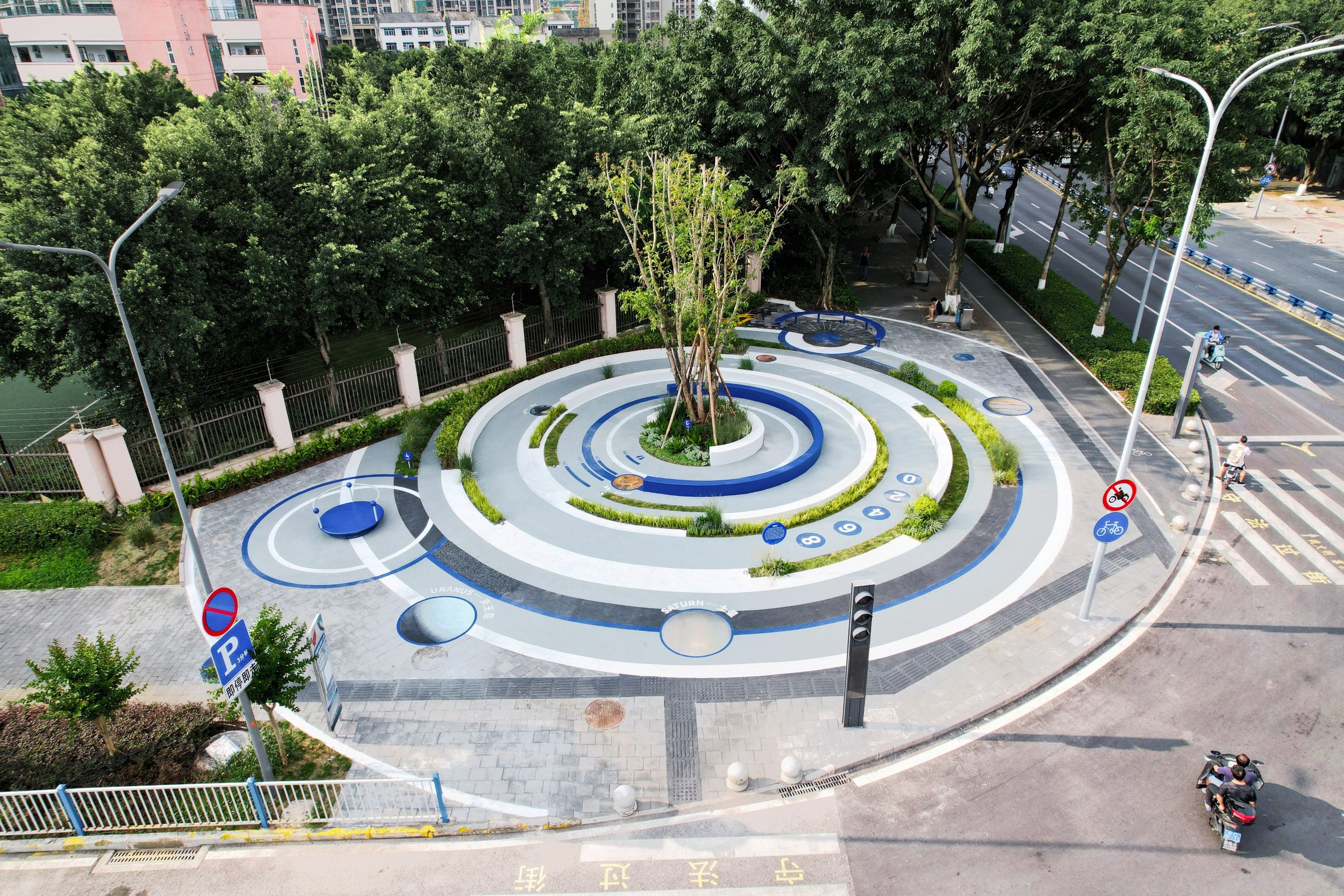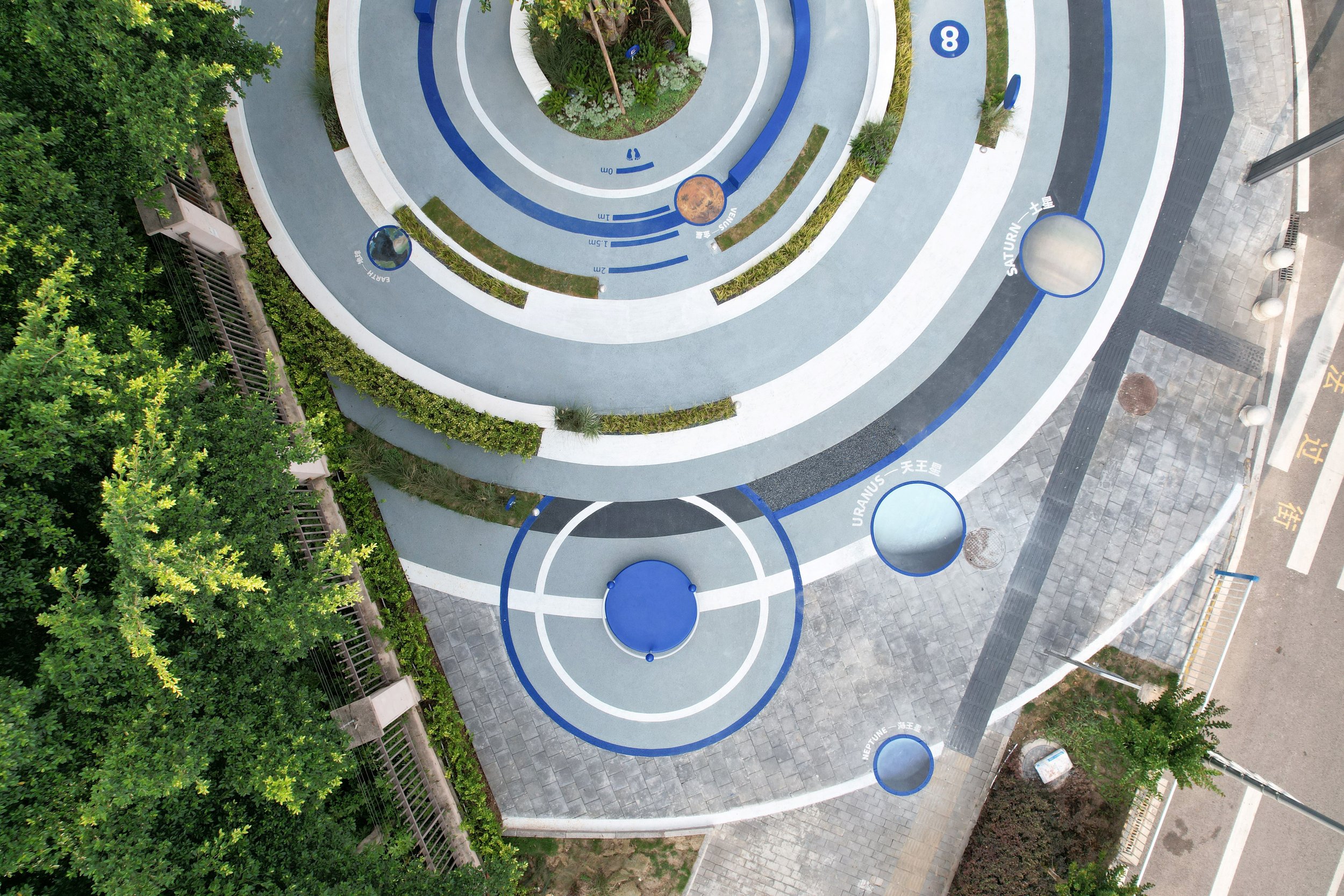High-Tech Quantum Pocket Park by 10 Design (China)
The site is located between Nankai Jingyang Elementary School and Chunmiao Kindergarten in the High-Tech Zone, adjoining the Higher Education Mega Center East Road. It occupies a street corner within the core area of the district, covering an area of approximately 800m². Due to its proximity to the urban thoroughfare and schools, the area is bustling with pedestrian traffic and a constant flow of vehicles.
The original site was characterized by a nondescript arrangement of tree pools and landscaping. Despite its location within a high footfall zone, the spatial functionality of the area was monolithic, lacking provisions for momentary pauses and interactive engagement. Additionally, the impassable green elements hindered pedestrian flow, elongating walking paths and causing inconvenience.
Based on comprehensive research and analysis of the site's current conditions and the surrounding user demographics, the design approach will be rooted in catering to the needs of the community. The objective is to leverage the site's renovation and transformation to address the scarcity of public facilities within the city and fulfill the diverse requirements for public spaces across all age groups. The intention is to create a shared space that is easily accessible for local residents to take leisurely strolls and unwind. Simultaneously, it will serve as a comfortable resting spot for parents of students, offering a place to relax while waiting. Additionally, the design aims to establish an interactive gaming haven where children can engage freely in play.
Core Concept: An Engaging Science Popularization Space in the High-Tech Perspective
To magnify the distinctive advantages of high-tech innovation and comprehensively enhance our capacity to drive the advancement of high-quality science and technology education, the theme of the park revolves around "Quantum Science". Complex and abstract scientific concepts such as "Atomic Nucleus", "Electron", and "Solar System" are distilled into a succinct design language, giving rise to more vivid and engaging representations through regional divisions, patterns, and other engaging depictions. Simultaneously, the design employs elemental circles to outline the plane, establishing configurations of enclosure, diffusion, and interplay, thereby laying the foundation for the unfolding of spatial narratives.
The circle, symmetrically centered, evokes a sense of balance and security, representing the most simplified visual motif. It is also the initial shape that children grasp in the process of drawing: various childlike sketches such as sun, fruits, animals, etc., are all built upon the foundation of circles. Children naturally possess an innate fondness and curiosity for circular forms.
The central shared area serves as the "Atomic Nucleus", while the leisure and interactive zones at both ends function as the "Electrons". Through human activities within the space, an energy field is generated, facilitating interconnectivity between different sections of the site and offering diverse interactive options.
The ground incorporates educational elements about the planets in the Solar System, creating a linkage from the microcosmic (quantum) to the macrocosmic (Solar System) realms.
Incorporating engaging facilities within the space, the scientific concepts are seamlessly integrated into the daily lives of the surrounding residents through lively and enjoyable means. This approach also allows participating children to step into the realm of science and develop an affection for it through relaxed and joyful outdoor activities.
Trajectories: Defining Space and Movement Paths
Centered around the core landscape feature, a circular trajectory is designed to draw attention towards the center, and this design concept gives rise to a series of layered landscape boundaries. This results in a three-tiered spatial structure consisting of outer, middle, and inner zones, each catering to the functional needs of public seating, plant communities, and interactive amenities, respectively.
By compressing the boundaries, the circular seating arrangement is designed with varying heights to accommodate people of all ages in a natural and pressure-free posture. This configuration also creates a visually dynamic and diverse spatial experience. To soften the impact of rigid interfaces, the trajectory boundaries are pushed downward, resulting in circular plant communities. These plant groupings with their fluctuating canopy lines add a more vibrant and livelier dimension to the space.
The trajectory from the inner to the outer zones defines a macroscopic pathway of quantum science, linking together nature, science, and culture.
Environmental Protection: Sustainable Habitat
On the cliffs, waterfronts, and streets of Chongqing, you can find a type of robust and flourishing tree with a strong sense of vitality –Huang Jue Tree. Referred to affectionately as "Huang Jue Tree" in Chongqing dialect, its botanical name is "Ficus Virens". Due to its remarkable adaptability and resilience, along with its luxuriant foliage and year-round beauty, the Ficus Virens has become the symbol of Chongqing's diligent, courageous, and tenacious spirit. Designated as the official city tree, it intertwines with people's lives and memories, embodying the essence of the city.
The plant design for the space prioritizes the stability, controllability, and locality of the plant community structure. Carefully selected from the local mountains and wilderness, the Huang Jue Tree serves as the backbone of the community. Around this cosmic center, a verdant oasis is cultivated. By combining wildflower paths and herbaceous elements, an ecosystem reminiscent of primal nature is established. The plant selection primarily includes evergreen herbs for year-round presence and is enriched with eye-catching species like "gaura" and "salvia". This diverse selection and presentation offer a spectrum of variations over an extended time frame, encouraging environmental stewardship and fostering a sense of happiness derived from the surroundings for the residents.








Revitalization: A Refreshing and Energetic Visual Experience
The visual impact of the site is closely tied to its influence on the urban landscape and its ability to attract users. The composition of various circular patterns of different sizes on the ground creates a dynamic and lively plane, adding vibrancy and dynamism to the plane.
The color selection for the site has been carefully considered. Drawing inspiration from the deep blue tones of the high-tech zone's logo, the brightness has been adjusted to align with children's visual preferences. The resulting color is akin to Klein Blue, representing intelligence, hope, technology, and dreams. The combination of blue and green creates a natural and harmonious blend, which seamlessly integrates the pocket park into the street landscape.
Exquisite designs and vibrant color combinations serve as a perfect magnet for catching people's attention, while also sparking children's interest in learning and understanding. Through play, these elements can enhance scientific knowledge and create an environment where dreams set sail amidst an "Ideal Blue" backdrop. What was once an unremarkable street corner has now transformed into a vibrant haven, where nearby residents gather for conversations, and children engage in lively games.
The Quantum Park achieves a dual purpose by intelligently utilizing the current context: not only does it enhance the street corner ambiance, but it also serves as a showcase for the "science" and "innovation" cultural essence of the Western China Science City. It encourages the harmonious interaction and engagement between citizens and the urban public space, fostering a sense of unity with the city's cultural identity.
In this corner of the street, it carries not only the outdoor activities and joyful voices of children but also symbolizes the essence of a city's warmth and people's aspirations for a better life.
Project: High-Tech Quantum Pocket Park
Project Location: Nankai Jingyang Elementary School, High-Tech Zone, Chongqing, China
Design Firm: 10Design
Presentation Date: July 2023

